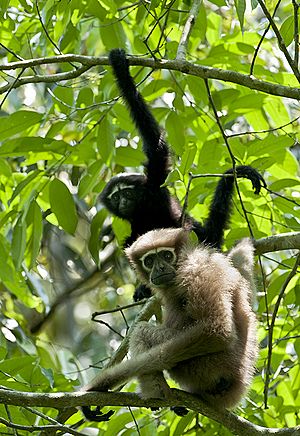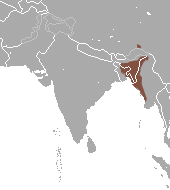Western hoolock gibbon facts for kids
Quick facts for kids Western hoolock gibbon |
|
|---|---|
 |
|
| A female in the foreground, and a male in the background | |
| Conservation status | |
| Scientific classification | |
| Genus: |
Hoolock
|
| Species: |
hoolock
|
 |
|
| Western hoolock gibbon range | |
| Synonyms | |
|
Simia hoolock protonym |
|
The western hoolock gibbon (Hoolock hoolock) is a type of primate from the gibbon family. Gibbons are known for their long arms and for swinging through trees. You can find this gibbon in parts of India (like Assam, Mizoram, and Meghalaya), Bangladesh, and Myanmar. They live in forests west of the Chindwin River.
Contents
About the Western Hoolock Gibbon
Scientists group animals to understand them better. For a long time, hoolock gibbons were thought to be part of a different group. But later, scientists like Mootnick and Groves decided they needed their own special group, called Hoolock.
At first, people thought there were two types of hoolock gibbons. Now, we know there are three distinct species:
- H. hoolock (the western hoolock gibbon)
- H. leuconedys (the eastern hoolock gibbon)
- H. tianxing (the Skywalker hoolock gibbon)
These three types of hoolock gibbons are actually quite different from other gibbons, even more so than bonobos are from chimpanzees. Recently, a new kind of western hoolock gibbon was found in northeastern India. It's called the Mishmi Hills hoolock gibbon (H. h. mishmiensis).
How Hoolock Gibbons Communicate
Like other gibbons, western hoolock gibbons are very vocal. Pairs of gibbons sing loud, complex songs together. They usually sing from high up in the forest trees. Younger gibbons in the family might join in too.
Their songs have different parts:
- An introduction
- An organizing part
- A "great call" part
The male gibbon also adds to the "great call" section. This is different from some other gibbon species where only the female makes this call.
Where They Live and What They Eat
In India and Bangladesh, western hoolock gibbons live in forests where the tree branches touch, forming a continuous cover. These are often wet evergreen forests with many different kinds of trees, including those found in mountainous areas.
These gibbons are important for the forest because they help spread seeds. Their diet mainly includes:
- Ripe fruits
- Some flowers
- Leaves
- Young shoots
They also eat non-plant items like silkworms, ants, and other insects. During the rainy season in northeast India, insects become their second favorite food. Their top favorite food during this time is the fruit from the Artocarpus chaplasha tree, which is related to the jackfruit.
Protecting the Western Hoolock Gibbon
Western hoolock gibbons face many dangers in the wild. They now rely on humans to help them survive. Some of the biggest threats are:
- Humans moving into their habitat
- Forests being cleared for tea farms
- Jhuming, which is a type of slash-and-burn farming
- Hunting them for food and traditional "medicine"
- Capturing them to sell as pets
- Damage to their forest homes
Since the 1980s, the number of western hoolock gibbons has dropped a lot. In the early 1970s, there were about 80,000 in Assam, India alone. Now, there are fewer than 5,000 in total. This is a decline of over 90%!
In 2009, this gibbon was listed as one of the 25 most endangered primates. While it's no longer on that specific list, the IUCN still considers it an endangered animal.
Many groups are working to protect the western hoolock gibbon's home. Organizations like World Land Trust and Gibbon Conservation Alliance help fund efforts to save these amazing primates.
See also
- Lawachara National Park


